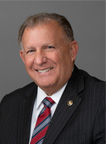H.B. 496 Technology and Life Science Economic Development Act and Related Tax Credits
| Bill Sponsor: Rep. Clark, David | Floor Sponsor:  Sen. Bramble, Curtis S. |
- Substitute Sponsor: Sen. Bramble, Curtis S.
- Drafting Attorney: Rebecca L. Rockwell
- Bill Text
- Other Versions
- Related Documents
- Information
- Last Action: 25 Mar 2011, Governor Signed
- Last Location: Lieutenant Governor's office for filing
- Effective Date: 10 May 2011
- Session Law Chapter: 306
Bill Status / Votes
• Senate Actions • House Actions • Fiscal Actions • Other Actions
| Date | Action | Location | Vote |
| 3/1/2011 | Bill Numbered but not Distributed | Legislative Research and General Counsel | |
| 3/1/2011 | Numbered Bill Publicly Distributed | Legislative Research and General Counsel | |
| 3/2/2011 | House/ received bill from Legislative Research | Waiting for Introduction in the House | |
| 3/2/2011 | House/ 1st reading (Introduced) | House Rules Committee | |
| 3/2/2011 | House/ to standing committee | House Business and Labor Committee | |
| 3/2/2011 | House Comm - Substitute Recommendation | House Business and Labor Committee | |
| 3/2/2011 | House Comm - Favorable Recommendation | House Business and Labor Committee | 9 1 4 |
| 3/2/2011 | Bill Substituted by Standing Committee | House Business and Labor Committee | |
| 3/3/2011 | House/ comm rpt/ substituted | House Substituted Bill | |
| 3/3/2011 | House/ 2nd reading | House Rules Committee | |
| 3/3/2011 | House/ lifted from Rules | House Rules Committee | |
| 3/3/2011 | House/ 2nd reading | House 3rd Reading Calendar for House bills | |
| 3/4/2011 | House/ 3rd reading | House 3rd Reading Calendar for House bills | |
| 3/4/2011 | House/ floor amendment | House 3rd Reading Calendar for House bills | |
| 3/4/2011 | House/ passed 3rd reading | Senate Secretary | 51 15 9 |
| 3/4/2011 | House/ to Senate | Senate Secretary | |
| 3/4/2011 | Senate/ received from House | Waiting for Introduction in the Senate | |
| 3/4/2011 | Senate/ 1st reading (Introduced) | Senate Rules Committee | |
| 3/4/2011 | House/ to Printing with fiscal note | Senate Rules Committee | |
| 3/7/2011 | House/ received fiscal note from Fiscal Analyst | Senate Rules Committee | |
| 3/9/2011 | Senate/ lifted from Rules | Senate Rules Committee | |
| 3/9/2011 | Senate/ placed on 2nd Reading Calendar | Senate 2nd Reading Calendar | |
| 3/9/2011 | Senate/ 2nd & 3rd readings/ suspension | Senate 2nd Reading Calendar | |
| 3/9/2011 | Senate/ circled | Senate 2nd Reading Calendar | |
| 3/10/2011 | LFA/ bill sent to agencies for fiscal input | Senate 2nd Reading Calendar | |
| 3/10/2011 | Senate/ uncircled | Senate 2nd Reading Calendar | |
| 3/10/2011 | Senate/ substituted | Senate Substituted Bill | |
| 3/10/2011 | LFA/ fiscal note publicly available | Senate Substituted Bill | |
| 3/10/2011 | LFA/ fiscal note sent to sponsor | Senate Substituted Bill | |
| 3/10/2011 | Senate/ passed 2nd & 3rd readings/ suspension | Clerk of the House | 28 0 1 |
| 3/10/2011 | House/ to Printing with fiscal note | Clerk of the House | |
| 3/10/2011 | Senate/ held for possible reconsideration | Senate Secretary | |
| 3/10/2011 | Senate/ placed back on 2nd Reading Calendar | Senate 2nd Reading Calendar | |
| 3/10/2011 | Senate/ 2nd & 3rd readings/ suspension | Senate 2nd Reading Calendar | |
| 3/10/2011 | Senate/ floor amendment | Senate 2nd Reading Calendar | |
| 3/10/2011 | Senate/ passed 2nd & 3rd readings/ suspension | Clerk of the House | 28 0 1 |
| 3/10/2011 | Senate/ to House | Clerk of the House | |
| 3/10/2011 | House/ received from Senate | Clerk of the House | |
| 3/10/2011 | House/ placed on Concurrence Calendar | House Concurrence Calendar | |
| 3/10/2011 | House/ concurs with Senate amendment | Senate President | 64 8 3 |
| 3/10/2011 | House/ to Senate | Senate President | |
| 3/10/2011 | Senate/ signed by President/ returned to House | House Speaker | |
| 3/10/2011 | Senate/ to House | House Speaker | |
| 3/10/2011 | House/ received from Senate | House Speaker | |
| 3/10/2011 | House/ signed by Speaker/ sent for enrolling | Legislative Research and General Counsel / Enrolling | |
| 3/11/2011 | Bill Received from House for Enrolling | Legislative Research and General Counsel / Enrolling | |
| 3/15/2011 | Draft of Enrolled Bill Prepared | Legislative Research and General Counsel / Enrolling | |
| 3/18/2011 | Enrolled Bill Returned to House or Senate | Clerk of the House | |
| 3/21/2011 | House/ enrolled bill to Printing | Clerk of the House | |
| 3/21/2011 | House/ to Governor | Executive Branch - Governor | |
| 3/25/2011 | Governor Signed | Lieutenant Governor's office for filing |
Committee Hearings/Floor Debate
- Committee Hearings
- Floor Debates
- House Floor Audio, Day 39 (3/4/2011) [HB0496S01]
- Senate Floor Audio, Day 44 (3/9/2011) [HB 496s1 - Bramble - 2nd reading, circled]
- Senate Floor Audio, Day 45 (3/10/2011) [HB 496ss2 - Bramble - 2nd & 3rd reading, uncircled, substituted, rules suspended, final passage]
- Senate Floor Audio, Day 45 (3/10/2011) [HB 496s2 - Bramble - recalled for reconsideration, circled ]
- Senate Floor Audio, Day 45 (3/10/2011) [HB 496s2 - Bramble - 2nd & 3rd reading, rules suspended, amended, final passage]